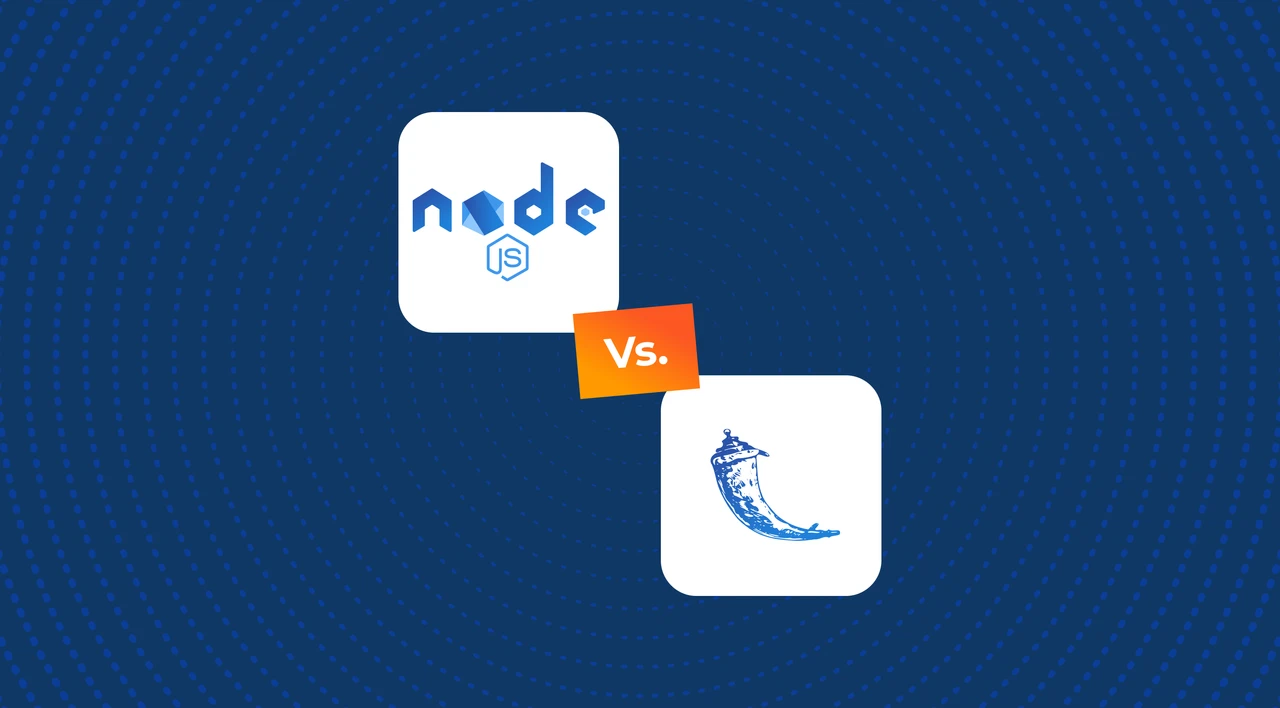SHARE
Node.js vs. Flask: Which is Better in 2026?

Contents
Contents
It’s every developer’s goal to choose the best framework for their project. Node.js and Flask are popular web frameworks used for building server-side applications.
In 2024, the two frameworks are still widely used and continue to have their own advantages and disadvantages.
This article has detailed descriptions of Node.js and Flask to help you make the best decision. Keep reading to find out!

What is Node.js?
Node.js is a JavaScript runtime environment built on Chrome’s V8 JavaScript execution engine.
It allows developers to run JavaScript on the server side, making it a popular choice for building scalable, real-time web applications.
Node.js also has a large and active community of developers, with many libraries and modules available.
What is Node.js used for?
Node.js is used for building server-side applications, such as web servers, APIs, and real-time applications. it
It is often used to build applications requiring high concurrency and real-time communication, such as chat applications, online gaming platforms, and social media networks.
Node offers developers over 5 ways through which they can make HTTP requests. This makes it possible to communicate and transfer data over the network.
Popular Node.js Web Frameworks
Below is a list of some of the widely used Node.js web frameworks.
Express.js
Express.js is a minimalist web framework for Node.js. It is the most widely used and popular Node.js framework.
Koa.js
Koa.js is a lightweight web framework for Node.js designed by the creators of Express. It is similar in functionality to Express but uses more modern JavaScript features.
Hapi.js
Hapi.js is a powerful web framework for Node.js. It is focused on building scalable network applications.
Nest.js
Nest.js is a progressive Node.js framework for building efficient, reliable, and scalable server-side applications. It is designed to be modular and scalable.

What is Flask?
Flask is a lightweight web framework written in Python programming language.
It is designed to be simple and easy to use, making it a popular choice for building small to medium-sized web applications.
Flask is also highly customizable and modular, allowing developers to choose only the features they need for their applications.
What is Flask used for?
Flask is used to build web applications, particularly those requiring a lightweight framework with minimal dependencies.
It allows developers to quickly and easily create web applications using Python.
The Flask framework provides a flexible and extensible architecture that can be customized to meet the specific needs of a project.
It is often used for building prototypes, small web applications, and APIs and prototyping new web applications or features.
Flask can also be used with other Python libraries and frameworks to build more complex applications and systems.
Advantages of Node.js over Flask
If you choose Node.js over Flask, below are some of the benefits you will enjoy from your choice.
Better performance
Node.js is built for handling I/O-intensive applications, making it a better choice for applications that require high concurrency and real-time communication.
Active community
Node.js has a large and active community of developers, with many libraries and modules available.
Familiarity with JavaScript
If you are already familiar with JavaScript, then Node.js can be an easier framework to learn and use.
Advantages of Flask over Node.js
Here are some of the elements you are likely to enjoy better with Flask compared to Node.js.
Simplicity
Flask is designed to be simple and easy to use, making it a good choice for building small to medium-sized web applications.
Lightweight
Flask has minimal dependencies, making it a good choice for building applications with limited resources.
Python Ecosystem
Flask is built in Python, with a vast library and module ecosystem that can be easily integrated into your application.
Node.js vs. Flask Comparison
When comparing Node.js and Flask, there are several factors to consider. They include:
Programming Language – Python vs. JavaScript
Node.js is built on JavaScript, while Flask is built on Python. Developers familiar with one language over the other may prefer to use that language.
Learning Curve
Flask is considered to have a lower learning curve than Node.js, making it easier for beginners to get started. Node.js can be more complex due to its asynchronous programming model.
Stability
Node.js and Flask are stable and reliable frameworks. However, Node.js has a reputation for being more stable for larger, more complex applications.
Community Support
Both frameworks have large and active communities of developers. However, Node.js has a larger community and a wider range of available resources.
Popularity
Both frameworks are popular, with Node.js being more widely used for web development, particularly for building real-time and data-intensive applications.
Flask is more commonly used for building smaller, simpler web applications.
Node.js vs. Flask: Which is Better?
Deciding whether Node.js or Flask is better depends on the specific needs of your project.
Node.js is a JavaScript runtime that is particularly well-suited for building scalable, real-time web applications.
It has a large and active community of developers and a wide selection of libraries and modules available.
However, it can have a steeper learning curve and may be more complex for beginners.
Flask is a lightweight web framework written in Python and designed to be simple and easy to use.
It is a good choice for building small to medium-sized web applications and prototypes, particularly for developers already familiar with Python.
It has a lower learning curve and is more lightweight than Node.js, but it may not be the best choice for larger or more complex applications.
Summary
Each of the frameworks has its own advantages and disadvantages. Choosing the one that best fits the needs of your project.
Ultimately, the choice between Node.js and Flask will depend on your project’s specific needs and requirements.
When making your decision, you need to consider factors such as programming language, learning curve, stability, community support, and popularity.
Frequently Asked Questions
What is the node package manager (NPM)?
the Node Package Manager, or NPM, is a package manager for Node.js that allows developers to install and manage packages and dependencies for their projects easily.
It is the default package manager for Node.js and is used to install and manage libraries and modules for Node.js projects.
What alternatives are there to Node.js and Flask?
There are many alternatives to Node.js and Flask, including:
The framework choice will depend on your project’s specific needs and your personal preferences.
How do you learn Node.js development?
To learn Node.js development, you can start by learning the basics of JavaScript, as Node.js is built on top of it.
Then, you can learn the fundamentals of Node.js, including its event-driven architecture and asynchronous programming model.
Many online tutorials, courses, and resources are available for learning Node.js development, including official documentation, online courses, and community forums.
What is a backend web framework?
A backend web framework is a set of tools and libraries that developers use to build the server-side components of web applications.
These frameworks provide a structure and set of conventions for building backend applications, including handling requests, managing databases, and processing data.
What is the difference between Django and Flask?
Django and Flask are web frameworks for Python, but they differ in design and purpose.
Django is a full-stack web framework that provides tools and features for building complex web applications.
It includes Object-Relational Mapping (ORM), authentication and authorization, and many other features out of the box.
On the other hand, Flask is a lightweight web framework designed to be simple and flexible.
It provides only the essential tools for building web applications and is often used for building small to medium-sized projects or APIs.
Professional Node.js Development Services
Flatirons Development offers top-rated Node.js development services.
Get the CEO's Take
Handpicked tech insights and trends from our CEO.
Professional Node.js Development Services
Flatirons Development offers top-rated Node.js development services.
Get the CEO's Take
Handpicked tech insights and trends from our CEO.

Enterprise Computing: Transforming Business Operations
Flatirons
Oct 09, 2025
Explore the Top Embedded Systems Examples of Today
Flatirons
Oct 04, 2025
Best Manual Testing Tools to Boost Your Software Quality
Flatirons
Sep 28, 2025
Digital Product Development: Enhance Your Business Offerings
Flatirons
Sep 12, 2025
React SEO: Optimize Your React Apps for Search Engines
Flatirons
Sep 07, 2025
Will Software Engineers Be Replaced by AI?
Flatirons
Aug 31, 2025